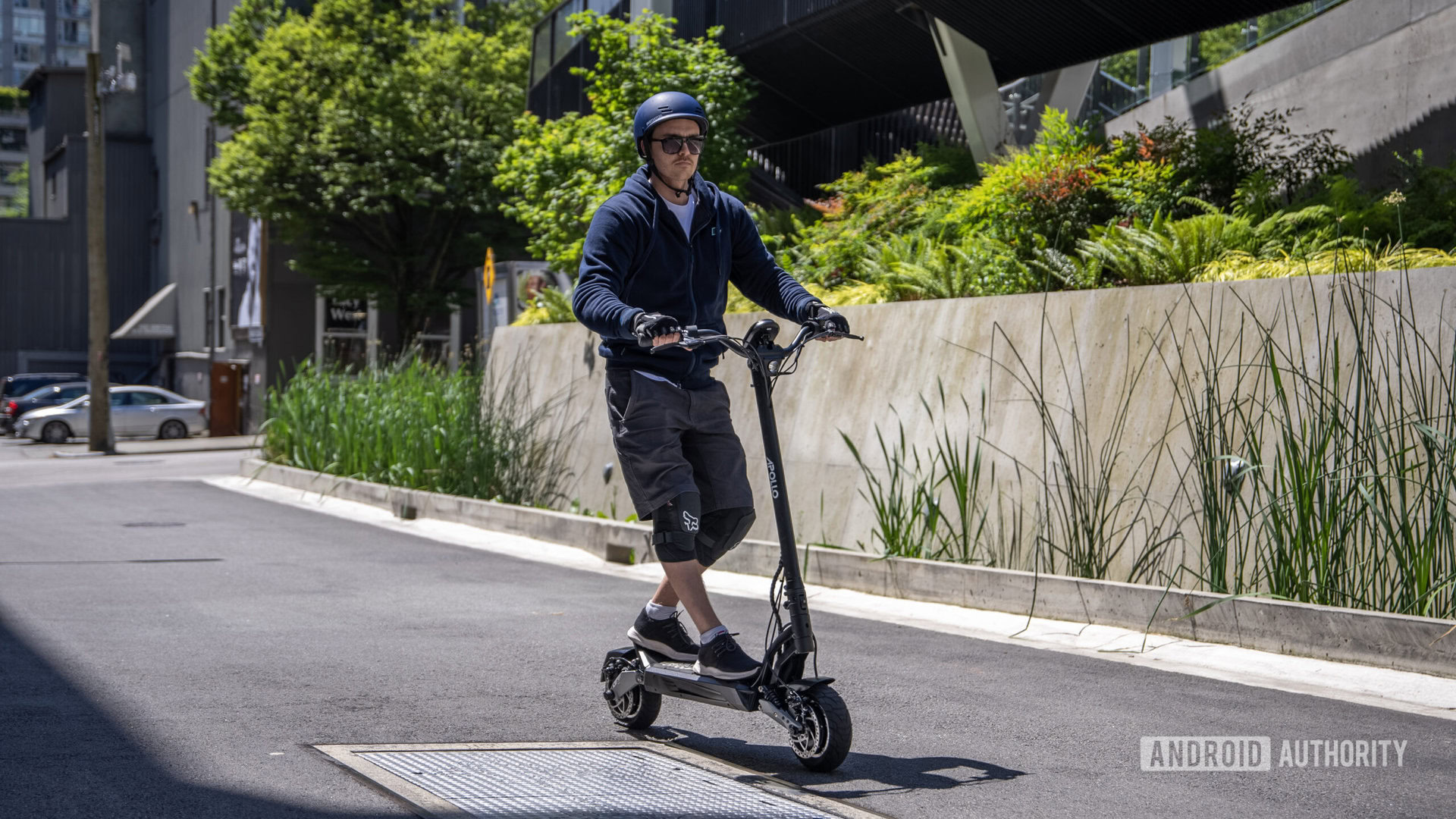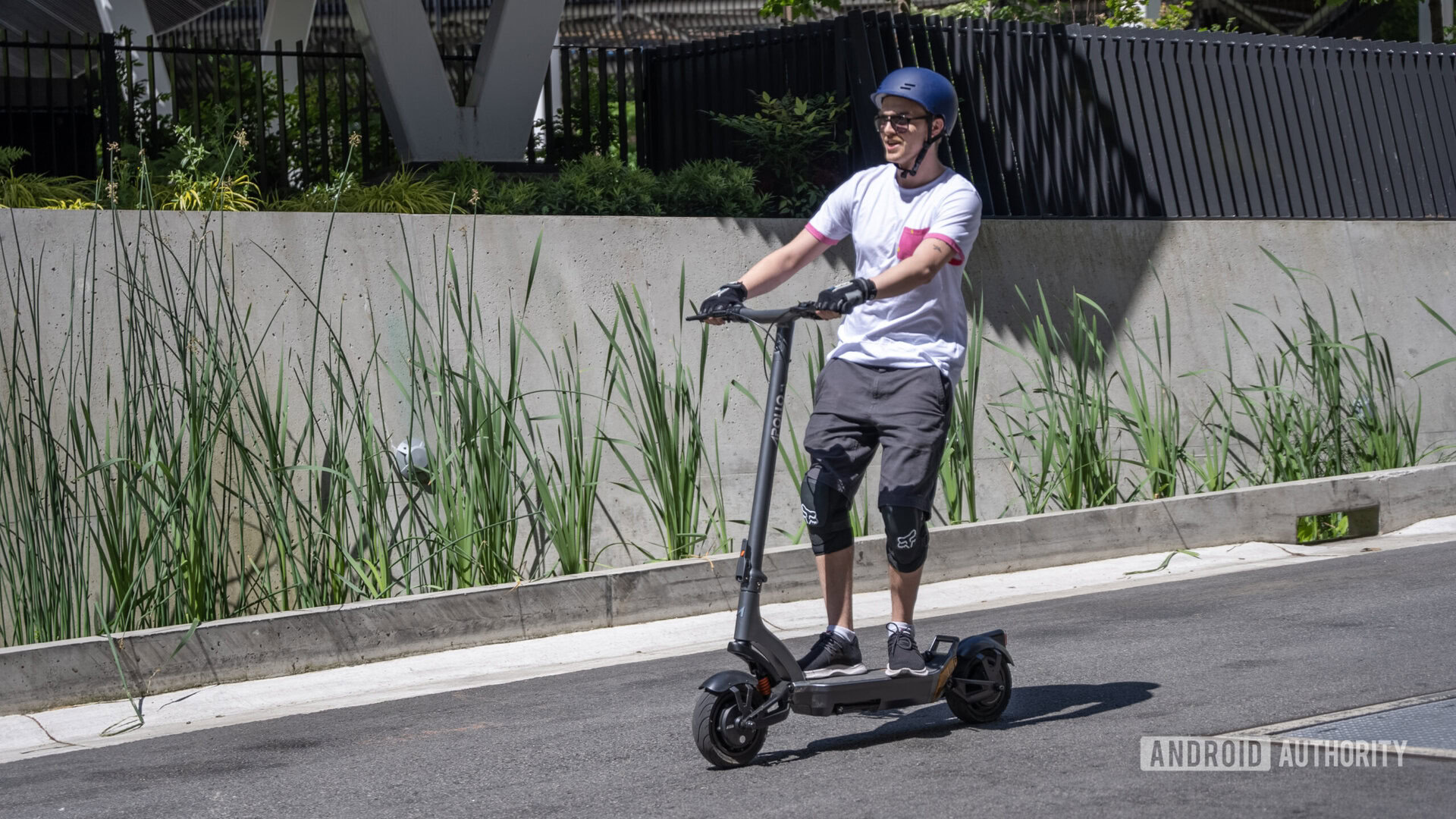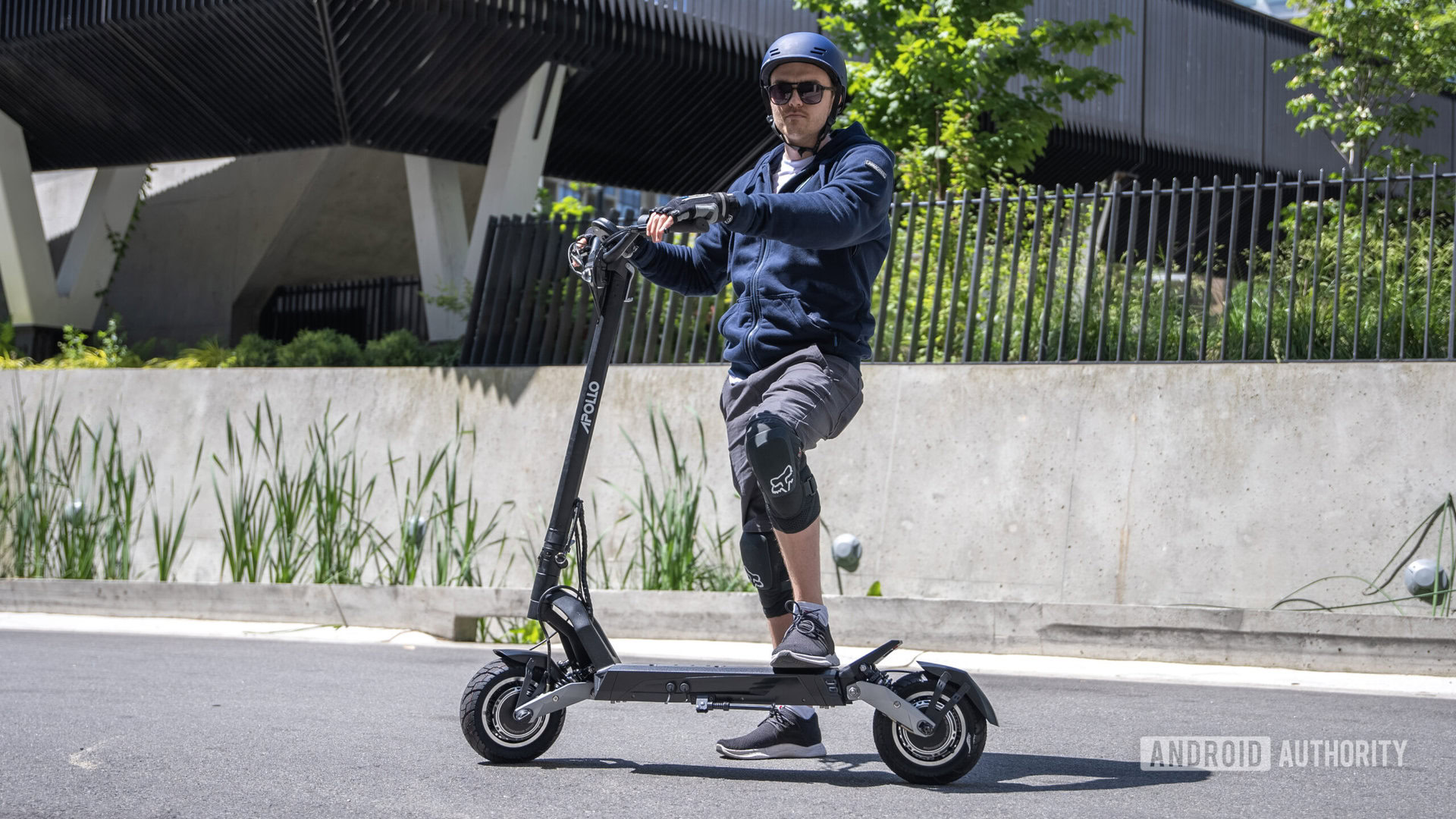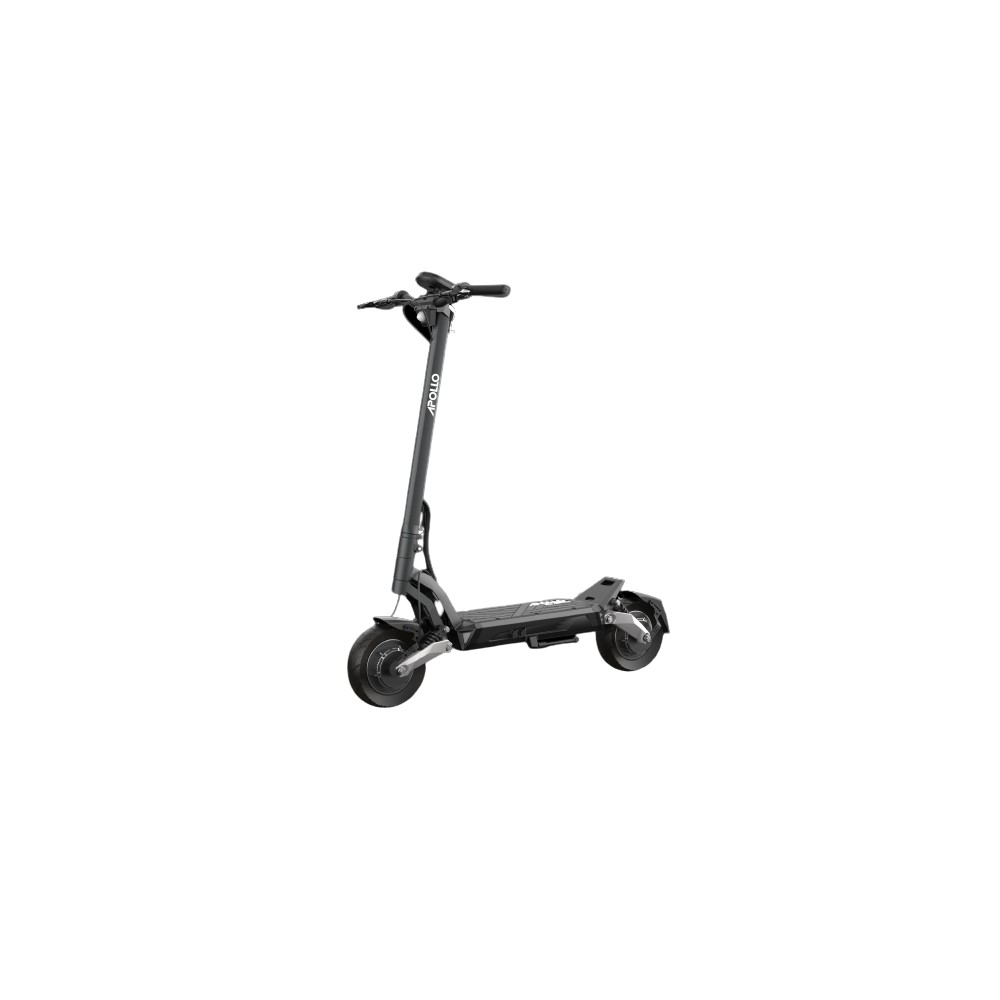Affiliate links on Android Authority may earn us a commission. Learn more.
I rode the Apollo Phantom V3, an electric scooter that reaches 41mph
Published onJune 11, 2023

There’s a new breed of speed demons on the streets, and these two-wheelers are taking the daily commute by storm. While I see many people in my city riding electric scooters recreationally, more and more are investing in high-performance scooters as their go-to mode of transportation. Some of these high-specced scooters redefine what we thought possible on two wheels, matching the speed limit for cars in some cities.
After testing Apollo’s latest expert model, the Apollo Phantom V3, and one of their commuter models, the Apollo City, I don’t think I’ll ever take the bus again. It is faster to get to work and adds a jolt of adrenaline to my morning Joe. Of course, not everyone may need a scooter that can blitz by at 40mph. Still, for thrill seekers like me or anyone curious about changing their typical travel, here’s why experiencing Apollo’s high-performance ride was an absolute game-changer.
What you need to know about the Apollo City and Phantom V3

- Apollo Phantom V3: $2,299 / CAD $2,599
- Apollo City: $1,399 / CAD $1,599
| Apollo City | Apollo Phantom V3 | |
|---|---|---|
Motor | Apollo City 500W | Apollo Phantom V3 2 x 1,200W |
Top speed | Apollo City 28 mph (45 km/h) | Apollo Phantom V3 41 mph (66 km/h) |
Max range | Apollo City 30 miles (48 km) | Apollo Phantom V3 40 miles (64 km) |
Battery | Apollo City 48V 13.5Ah | Apollo Phantom V3 52V 23.4Ah |
Charge time | Apollo City 4.5 hours | Apollo Phantom V3 12 hours |
Riding modes | Apollo City Gear 1: 9 mph Gear 2: 18 mph Gear 3: 27 mph | Apollo Phantom V3 Gear 1: 15.5 mph Gear 2: 25 mph Gear 3: 38 mph Ludo: 41 mph |
Max incline | Apollo City 10 degrees | Apollo Phantom V3 25 degrees |
Tires | Apollo City 10-inch self healing tubeless tires | Apollo Phantom V3 10-inch pneumatic tires |
Suspension | Apollo City Triple spring system | Apollo Phantom V3 Quadruple spring system |
Brakes | Apollo City Dual drum brakes and regenerative electronic braking | Apollo Phantom V3 Front and rear disc brakes and regenerative electronic braking |
Visibility | Apollo City 500 lumen headlight Rear turn signals Brake light | Apollo Phantom V3 1,000 lumen headlight Front and rear turn signals Brake light |
Water resistance | Apollo City IP66 | Apollo Phantom V3 IP54 |
Weight | Apollo City 57 lbs | Apollo Phantom V3 77 lbs |
Rider weight | Apollo City 220 lbs | Apollo Phantom V3 300 lbs |
Looking over the specs sheet, you can see these electric scooters pack quite a punch. But it’s not just raw power that sets the Apollo scooters apart, but the design and features you get. The City and Phantom V3 have a thumb throttle on the right and a dedicated regenerative braking throttle on the left to slow down instead of the hand brakes. The benefit of a regen brake is that it can recharge the battery by up to 10% to give you a little more range and also gives the mechanical brakes a break from wear and tear. The scooters also feature turn signals to help other vehicles see you coming.
The Apollo City 2022 is a complete redesign from previous models. Unlike many electric scooter manufacturers that rely on OEM production, using mass-made parts you’ll see across competitors, Apollo went completely custom with their design here, crafting every component for what they believe to handle the urban environment best. Sure, there are stylish touches, such as the display and headlights fitting flush within the space-grey frame, but there are a lot of practical features too.
On the Apollo City, you are getting self-healing tires that will ooze some gel to seal any punctures you may encounter on the road. And you will want to stick to paved streets as this scooter isn’t meant to be taken off-road. The self-healing technology isn’t there with the Phantom V3, but you are getting more durable pneumatic tires with a tread that can handle hard-packed trails. It also comes with spare inner tubes in case you get a puncture, and Apollo sells plenty of spare parts, such as replacement tires, if you have a bad blowout.
Plus, if you already have the Phantom V2, you can get an upgrade kit for only $499, including the new bigger, brighter display, updated regen and acceleration throttles, battery adapter, and efficient M1 controller. The modular capacity of these scooters is appreciated since you don’t have to buy a whole new scooter to take advantage of all the latest features.
Both scooters are foldable so that they can fit in the trunk of a car, but they are both fairly heavy to carry. As for the assembly, the Apollo City arrives ready to ride, with only a few screws to mount the integrated handlebar and display. The Apollo Phantom V3, however, requires a bit more elbow grease. The handlebars, display, headlight, and control modules are all separate pieces that require installation, and there are a couple of wires to connect. They come with a toolkit with everything you need to put them together, and they arrive charged out of the box, so once you get them built, you can ride them right away.
What it’s like to ride the Apollo Phantom V3 and City

Until now, I had only ridden scooters below the $1,000 price bracket, and it was a big leap forward experiencing the high-performance space. For starters, the suspension and shock absorption was a delight. Very few recreational scooters have suspension, but the springs really make a difference, especially when riding on a daily basis. The Apollo City sports two bright orange springs on the back and one up front, while the Phantom V3 has four in total, with two on either side of the wheels. It makes for smooth rolling over any bumps and cracks on the road, but it’s just that much more buttery on the Phantom.
From the moment I stepped onto the scooters, I was hooked. The purr of the electric motor, the wind streaming past my helmet — it was intoxicating.
The Apollo City has a stated top speed of 28 mph, with its highest gear setting, which is plenty fast to beat the traffic using the bike lanes beside the main road. It hardly slows down up inclines either, something that weaker motors on budget scooters tend to struggle with. I did experience some speed wobble at top speeds with the City, so I usually stick to around 20 mph just to be safe, especially in the busy inner-city traffic. You also get 30 miles of range, which was more than enough for me to travel to and from work (~6 miles) for several days on a single charge.
As for the Phantom V3? It was unlike anything I’ve experienced standing on two wheels, like strapping a rocket to my feet. It really is a whole other beast when it comes to speed. Maxing out at 41 mph in LUDO mode (short for ludicrous), it was pretty surreal to be going the same speed as cars over the bridge and amusing to see their surprised expressions as I rode parallel to them on the road. Of course, you will need to wear proper gear when going so fast, such as a helmet and even knee pads and elbow pads in case you take a spill. If you aren’t familiar with riding scooters, get comfortable with the lower gear settings before you start hitting the speed limit.
Apollo’s new March 1 controller is the brain behind the ride, which Apollo says is 27% more efficient than stock controllers. A quick press of the thumb throttle is all it takes to scoot ahead of the pack and stopping can be just as sharp and sudden. The handling is much better than the City at high speeds, and I always felt in control of my maneuvers. As soon as you hit the throttle, the scooter carries you away with its spacious deck and ultrawide handlebars. It’s gripping to ride, and I hardly ever have to charge the scooter since it provides 40 miles of range (25 miles at max power), which is good since it can take up to 12 hours to replenish the depleted battery cells.
Another feature I appreciate is the turn signals. Riding a scooter, it can be hard to use hand signals as you would on a bike since it’s hard to maintain balance while standing with one hand on the handlebars. Here it’s much easier to do a quick shoulder check and then activate the left or right turn signal with the press of a button. On the Apollo City, the reflective rear signals are cleverly designed as an arrow shape for added visibility. On the Phantom V3, you get turn signal lights at both the front and back of the deck, so cars in front of you can see you coming in their rearview mirror. I would have liked turn signal lights at the end of the handlebars as well since the ones along the deck can be a little low for cars to see, but that is a feature Apollo is adding in their upcoming Explore scooter, so there might be an upgrade kit to pick up in the future.
Speaking of the handlebars, while the Phantom V3’s are more ergonomic with an up-curved swooping shape compared to the City’s straight look, I found the wider length made it harder to reach the button controls, especially on the left side where I have to stretch my thumb past the bell to press the throttle. The City features a more modern bell design with a lever up by the handbrakes, which was much easier to access.
Let’s talk about the Apollo Mobile app
Apollo isn’t the first to have an accompanying mobile app for electric scooters, but it may be the most useful one I’ve tested. Aside from recording your trip’s distance and speed, you can tweak a lot of the settings on your scooter, such as the strength of the acceleration and braking response, how long before cruise control activates, and how long your scooter can be left on before automatically shutting down. You can also set a custom max speed for Sport mode if you find it too fast or as a parental control measure for young ones.
The app also has map analytics to track everything about your rides, from duration and average speed to how much battery you consumed and the temperature of the controller and motors. I didn’t realize how valuable all this data was until I had it available. I soon became a bit of a data junkie, comparing which routes would save the most battery life, how fast I could race down the nearby greenway, and which hills would heat my motors the most as they powered up them.
Like Google Maps, you can punch in a destination, and the map will give you a route recommendation with an estimated time and distance of the trip, and you can save your work and home locations for quick directions. When not riding the scooters, you can lock them using the app so that the wheels won’t turn and will make a noise.
Occasionally, I had a few issues pairing the app to my scooter over Bluetooth and would have to either restart the app or turn it on and off again to get them to pair. But they never disconnected while I was recording a ride. There aren’t any ads, but Apollo also has a virtual storefront in the app, which I didn’t visit much but can be a quick way to browse accessories or upgrades for your scooter.
Who are these extreme scooters for?
Some readers may wonder if riding at these speeds on an electric scooter is even legal. The answer depends on where you live. In the US, electric scooters are fully legal with a driver’s license in most states, and only some states specify maximum speed limits, usually around 15 mph to 20 mph.
In my hometown of Vancouver, BC, our city is currently in a pilot program with guidelines that aren’t really enforced. I frequently see people without helmets with a second passenger on deck without consequence. I asked Apollo how they feel about this as a Canadian company selling scooters that can reach the speed limit for cars. They said that because it is a grey area, they get away with it while always encouraging people to be responsible. But more importantly, scooters with these specs are really what their customers are asking for as an alternative commuter vehicle to something with a gas-guzzling engine.
Riders are asking for high-specced scooters as an alternative to gas-guzzling car engines.
And that’s the point. If we want people to adopt more eco-friendly means of transportation for their daily commute and errands, I’m sorry to say, but a low-end scooter with only a 500W motor and 20km of range just isn’t going to cut it. Plus, aside from commuters, delivery drivers can get from A to B faster without worrying about parking on a more powerful and well-built scooter that feels safe.
It isn’t just about the raw speed and power, either. Believe it or not, some scooters can go faster, but they don’t have as many premium components. Despite the hardcore look of Apollo’s scooters, I never felt in danger riding them. In fact, because of the quality materials and sturdy frame, I felt safer than riding a “legally” spec’d scooter with flimsy plastic fenders, reflective stickers, and no hydraulic brakes, suspension, or turn signals.
Seeing how different both scooters look from their first iterations shows me that Apollo is listening to the feedback and concerns of real-world riders. The IP54 and IP56 water resistance ratings, plus small touches like oil painting over the space-grade aluminum alloy frame to resist corrosion, show that these scooters are ready to withstand the elements. Then there’s also the range of accessories, such as bags for extra storage, folding locks, and even cup holders.
These micro-mobility two-wheelers are quickly approaching capabilities that rival cars in terms of speed, carry weight, and range, so why not let people ride them? Indeed it will require more precise regulation with stricter enforcement and maybe even a new license, but it is possible to execute safely. Once again, it’s the pattern of technology evolving faster than our legal systems can keep up with.
Apollo Phantom V3 and City: Closing thoughts

My experience with Apollo’s high-performance electric scooters has revolutionized my daily commute. The impressive speed and power of the Apollo Phantom V3 and the comfortable, commuter-friendly design of the Apollo City have changed my perception of what micro-mobility can be. The agility, speed, and compact nature of these scooters make them more than capable of replacing traditional vehicles for cutting through the concrete jungle.
The Apollo City, with its custom design and self-healing tires, is ideal for urban commuters seeking a reliable, efficient, and fun ride. On the other hand, the Apollo Phantom V3, with its mind-bending speed and range, caters to thrill-seekers and long-distance riders without compromising comfort or safety (provided you wear the proper equipment).
The agility and speed of these scooters make them more than capable of replacing traditional vehicles for cutting through the concrete jungle.
Moreover, it’s worth mentioning that Apollo also offers a third model: the Apollo Ghost. Although I didn’t get the chance to test it, this model sits comfortably between the City and Phantom V3 in terms of performance and price. The Ghost might be worth considering if you’re looking for a balance of speed, power, and value. All three can sync with the Apollo mobile app, which despite minor pairing issues, adds another layer of customization, making your ride truly personal and smart.
Alternatively, if you want something slower with comfortable suspension and ample range, the Xiaomi 4 Ultra is a reliable electric scooter. It has dual suspension, a 500W motor, a 25km/hr top speed, and 25 miles of range. It’s a safe bet that meets the legal requirements for inner-city trips but might not be enough “oompf” for the hardcore commuters Apollo appeals to.
As we look to the future, the legal landscape needs to adapt quickly to accommodate these advanced modes of transport. These high-performance scooters are testimony to the potential of electric micro-mobility in reshaping urban landscapes, making them more sustainable and efficient. Ultimately, it’s not just about the thrill or the speed; it’s about embracing a new, sustainable way of moving around our cities that is practical and exciting.
While it’s essential to remember the legal boundaries and safety precautions when riding these high-performance scooters, there’s no denying they are a game-changer. We’re one step closer to a future where traffic jams are a thing of the past, and the streets are bustling with these nimble, silent speedsters.

